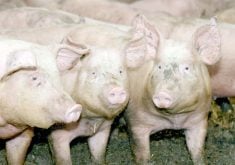INNISFAIL, Alta. – It is just a matter of time before bad cases of fusarium head blight show up in Alberta.
Grain samples have been studied in Alberta since 1995 and every year a few more fields show symptoms of the disease, which has decimated cereal crops in Manitoba and the Dakotas.
“In Alberta we do have fusarium head blight but the species of fungus is different,” said Agriculture Canada researcher Kelly Turkington.
The damaging fungus is known as fusarium graminearem, as opposed to the less damaging species found in Alberta, fusarium avenaceum.
Read Also

The Western Producer Livestock Report – October 2, 2025
Western Producer Livestock Report for October 2, 2025. See U.S. & Canadian hog prices, Canadian bison & lamb market data and sale insight.
“Fusarium avenaceum is not as big an issue. Fusarium graminearem produces micro-toxins that impacts food and feed,” he said.
While the disease has been detected at very low levels, farmers are already on the alert.
Alberta barley growers are worried it could be carried into the province from Manitoba or eastern Saskatchewan in a truckload of grain bound for feedlots.
Fusarium has been declared a pest under the pest control act in Alberta and a special committee was established to monitor the disease.
Research at Agriculture Canada’s Lacombe Centre will measure the incidence of the disease, as well as means of transmission.
Most work has been conducted on wheat samples because the symptoms are easier to detect. Diseased barley grains can be confused with spot blotch or kernel smudge.
Working with the Canadian Grain Commission, researchers have studied samples of kernels and heads from fields across the province and found the highest incidence of fusarium is in southern Alberta.
The samples contained 250 kernels and usually showed one or two were infected. However, some southern samples had as many as 20 diseased kernels.
The disease is spread through the movement of seed from an infected area. It can also leapfrog through fields as the wind drifts across diseased plants and soil.
“It’s unlikely you’ll see movement by wind to Alberta from Manitoba,” said Turkington.
One study involves sifting through manure to see if infected barley can survive in a steer’s rumen. Results are inconclusive.
Another more likely method of transmission could happen when barley is spilled from feed bunks and gets scooped up when the pens are cleaned. The manure is spread on the fields and the infected seeds could germinate and trigger the disease cycle.
Fields are most at risk during periods of high humidity and frequent rain showers when the grain is flowering and forming heads.
In southern Alberta’s irrigated regions this could pose a problem.
“Irrigators might avoid watering during heading of wheat and barley since that may increase the risk of these diseases,” said Turkington.
No crops are entirely resistant to the fungus but Turkington is confident plant breeders could have new resistant grains within three years. This could buy Alberta enough time before fusarium is a major problem.
The fusarium problem will be discussed at a national conference in Winnipeg Nov. 28-30.

















